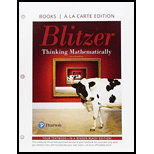
Concept explainers
One of the best ways to learn how to solve a word problem in algebra is to design word problems of your own. Creating a word problem makes you very aware of precisely how much information is needed to solve the problem. You must also focus on the way to present information to a reader and on how much information to give. As you write your problem, you gain skills that will help you solve problems created by others. The group should design five different word problems that can be solved using linear equations. All of the problems should be can different topics. For example, the group should not have a more than one problem on price reduction. The group should turn in both the problems and their algebraic solutions.
Want to see the full answer?
Check out a sample textbook solution
Chapter 6 Solutions
Thinking Mathematically, Books A La Carte Edition Format: Unbound (saleable)
Additional Math Textbook Solutions
Pathways To Math Literacy (looseleaf)
Precalculus: A Unit Circle Approach (3rd Edition)
Elementary and Intermediate Algebra: Concepts and Applications (7th Edition)
Elementary Statistics ( 3rd International Edition ) Isbn:9781260092561
Intro Stats, Books a la Carte Edition (5th Edition)
Finite Mathematics for Business, Economics, Life Sciences and Social Sciences
- 5) You are purchasing a game for $30. You have a 5% off coupon and sales tax is 5%. What will your final price be? Does it matter if you take off the coupon first or add in the tax first? 6) You have ten coupons that allow you to take 10% off the sales price of a jacket, and for some strange reason, the store is going to allow you to use all ten coupons! Does this mean you get the jacket for free? Let's really think about what would happen at the checkout. First, the teller would scan the price tag on the jacket, and the computer would show the price is $100. After the teller scans the first coupon, the computer will take 10% off of $100, and show the price is $90. (Right? Think about why this is.) Then after the teller scans the second coupon, the computer will take 10% off of $90. (a) Continue this reasoning to fill in the table below showing the price of the jacket (y) after you apply x coupons. (b) Make a graph showing the price of the jacket from x = 0 to x = 10 coupons applied.…arrow_forwardDetailed report without CHATGPT, accept if you can give with code and plots, previous reported . Do not waste my question.arrow_forwardPlease do not give inappropriate solutions, previous question reported, i need correct report solution for this, NO CHATGPTarrow_forward
- Need detailed report without CHATGPT, accept if you can give with code and plots, previous reported Plots are required.arrow_forwardNeed detailed report without CHATGPT, accept if you can give with code and plots, previous reportedarrow_forwardWhat would you say about a set of quantitative bivariate data whose linear correlation is -1? What would a scatter diagram of the data look like? (5 points)arrow_forward
- 1. Which set of parametric equations is shown in the graph below? Explain your reasoning. a) x = t; y = t² b) x = = t²; y = t -3-2-1 5 4 3 2 1 12 3 2. Using the graph of f, a. determine whether dy/dt is positive or negative given that dx/dt is negative and b. determine whether dx/dt is positive or negative given that dy/dt is positive. Explain your reasoning. 2 f x 1 2 3 4arrow_forwardFind the perimeter of the triangle. Express the perimeter using the same unit of measure that appears on the given sides. 9 ft 13 ft 6 ft The perimeter isarrow_forwardUse the formula for Pr to evaluate the following expression. 9P5 9P5 =☐arrow_forward
- Find the volume of the figure. The volume of the figure is 3 m 3 m 3 marrow_forwardFind the circumference and area of the circle. Express answers in terms of and then round to the nearest tenth. Find the circumference in terms of C= (Type an exact answer in terms of x.) Find the circumference rounded to the nearest tenth. C= Find the area in terms of A= (Type an exact answer in terms of x.) Find the area rounded to the nearest tenth. A= 10 cmarrow_forwardSox & Sin (px) dx 0arrow_forward
 Algebra: Structure And Method, Book 1AlgebraISBN:9780395977224Author:Richard G. Brown, Mary P. Dolciani, Robert H. Sorgenfrey, William L. ColePublisher:McDougal Littell
Algebra: Structure And Method, Book 1AlgebraISBN:9780395977224Author:Richard G. Brown, Mary P. Dolciani, Robert H. Sorgenfrey, William L. ColePublisher:McDougal Littell Elementary AlgebraAlgebraISBN:9780998625713Author:Lynn Marecek, MaryAnne Anthony-SmithPublisher:OpenStax - Rice University
Elementary AlgebraAlgebraISBN:9780998625713Author:Lynn Marecek, MaryAnne Anthony-SmithPublisher:OpenStax - Rice University

 Glencoe Algebra 1, Student Edition, 9780079039897...AlgebraISBN:9780079039897Author:CarterPublisher:McGraw Hill
Glencoe Algebra 1, Student Edition, 9780079039897...AlgebraISBN:9780079039897Author:CarterPublisher:McGraw Hill Intermediate AlgebraAlgebraISBN:9781285195728Author:Jerome E. Kaufmann, Karen L. SchwittersPublisher:Cengage Learning
Intermediate AlgebraAlgebraISBN:9781285195728Author:Jerome E. Kaufmann, Karen L. SchwittersPublisher:Cengage Learning





